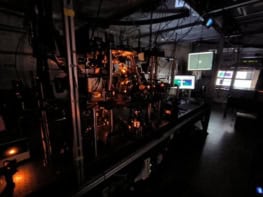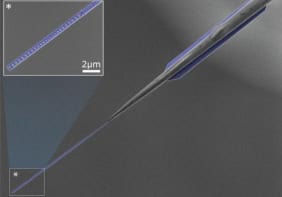
Adhesive tape is turning out to be an unexpected scientific tool. It is already used to make graphene — a layer of carbon one atom thick that has remarkable electronic properties — by peeling the surface off a piece of graphite using sticky tape. Now, researchers in the US have used this household item to generate nanosecond-length X-ray bursts. They show that simply peeling the tape from its roll can create flashes of X-rays intense enough to record images of a human finger.
The phenomenon of generating visible light by moving contacting surfaces relative to one another — known as triboluminescence — has been known for hundreds of years. Indeed, English scholar Francis Bacon noted in the seventeenth century that sugar sparkles when broken or scraped in the dark. Then in the 1950s and 1980s Russian groups showed that peeling tape could generate high energy electrons and X-rays, although these results were never reproduced in the West.
The latest research has been carried out by Seth Putterman and colleagues at the University of California, Los Angeles (Nature 455 1089).
To be honest we didn’t believe that peeling tape would generate X-rays Seth Putterman, UCLA
Putterman and co-workers placed an off-the-shelf roll of Scotch tape on a ball bearing mounted on stiff spring leaves and attached the free end of the tape to a cylinder turned by an electric motor. They then used a solid-state detector and a radiofrequency antenna to measure any X-rays and radio waves given off from the point at which the tape left the roll, and calculated the force needed to peel the tape via induction measurements of the leaves’ displacement. The whole set up was placed in a vacuum chamber.
Putterman’s group recorded X-ray emission in the form of intense bursts some billionth of a second long (with the width of the X-ray pulses calibrated using the well characterized radiowaves), and found that these bursts are correlated with very slight slippages (i.e. reductions in force) in the otherwise smooth removal of the tape from its reel.
Eureka moment
The researchers then used their set up to record images of a number of objects, including the finger of a group member using 20 second long exposures. “To be honest, we didn’t believe that peeling tape would generate X-rays. The glow of the X-ray scintillator was a eureka experience for me,” said Putterman, referring to the group’s initial detection of X-rays from their tape made using a zinc-sulphide scintillating screen.
The group believes that as the tape peels the acrylic adhesive on the exposed tape becomes positively charged and the outer surface of the remaining polyethylene roll acquires a negative charge. This causes electric fields to build up to values that trigger discharges.
A ‘new inspiring mystery’
The researchers say that at the reduced pressure in the experiment — about one millionth of an atmosphere — the discharges accelerate the electrons to energies that generate X-rays when they suddenly decelerate in the positive side of the tape. However, the researchers remain stumped as to how the diffuse mechanical energy needed to peel the tape is focused to the extent that it can produce X-rays, and even more strangely how it can do so in the form of nanosecond pulses. This, says Putterman, gives us a “new inspiring mystery to dig into”.
The research also suggests one or two practical applications. Putterman has applied for a patent for the imaging potential of the technique, pointing out that it could lead to a portable X-ray device that would not require a high voltage power supply. In addition, he says, humble sticky tape might one day become a new energy source. He points out that X-ray emission from peeling tape is similar to sonoluminescence — the production of light using sound waves to collapse bubbles very rapidly — in that both phenomena involve enormous multiplication of energy densities.
There has been much controversy over whether sonoluminescence can generate energy via fusion reactions, but Putterman believes that it is a line of research worth pursuing.




